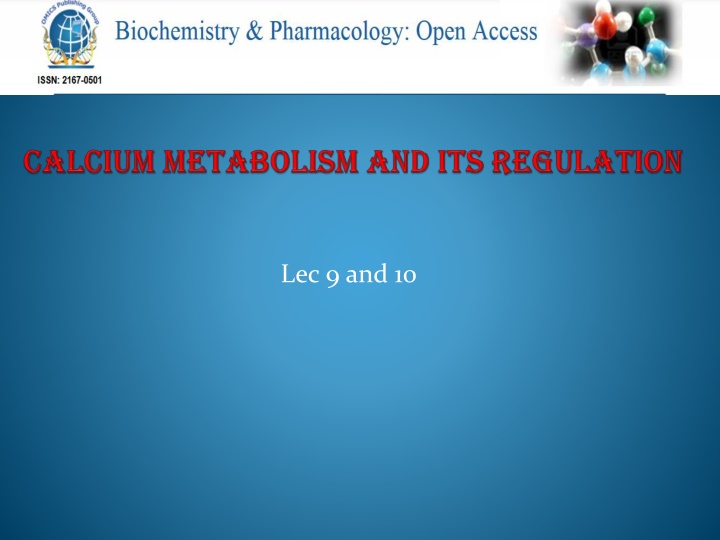
Understanding Calcium: Functions, Sources, and Requirements
Discover the different forms of calcium in the body, its essential functions like bone mineralization and neuromuscular regulation, absorption factors, and hormone regulation. Find out calcium requirements based on age and sources rich in calcium. Enhance your knowledge about this vital mineral for overall health.
Download Presentation

Please find below an Image/Link to download the presentation.
The content on the website is provided AS IS for your information and personal use only. It may not be sold, licensed, or shared on other websites without obtaining consent from the author. If you encounter any issues during the download, it is possible that the publisher has removed the file from their server.
You are allowed to download the files provided on this website for personal or commercial use, subject to the condition that they are used lawfully. All files are the property of their respective owners.
The content on the website is provided AS IS for your information and personal use only. It may not be sold, licensed, or shared on other websites without obtaining consent from the author.
E N D
Presentation Transcript
Different Forms of Calcium Most of the calcium in the body exists as the mineral hydroxyapatite, Ca10(PO4)6(OH)2. Calcium in the plasma: 45% in ionized form (the physiologically active form) 45% bound to proteins (predominantly albumin) 10% complexed with anions (citrate, sulfate, phosphate) Both total calcium and ionized calcium measurements are available in many laboratories
Body requirements Age (in years) Calcium Requirement 1 3 500mg 4 - 8 800mg 9 - 18 1300mg 19 - 50 1000mg 51+ 1500mg *Pregnant and lactating women are recommended a daily calcium intake of 1000mg.
source Calcium is found in milk and dairy products, Green leafy vegetables, seafood, almonds, blackstrap molasses, broccoli, enriched soy and rice milk products, figs, soybeans and tofu.
Absorption of Ca Absorption is taking place from the first and second part of duodenum against concentration gradients Absorption required a carrier protein , helped by Ca-dependent ATPase Increased absorption- - calcitriol , active form of Vit-D - PTH - acidic pH - Lys and Arg Inhibiting absorption - - phytic acid - oxalates - phosphate - Mg - caffeine
Biological functions of Calcium Bone and teeth mineralization Regulate neuromuscular excitability Blood coagulation Secretory processes Membrane integrity Plasma membrane transport Enzyme reactions Release of hormones and neurotransmitters Intracellular second messenger
Hormone regulation of calciummetabolism Vitamin D Calcitonin Parathyroid hormone (PTH) Organ-target: bones, kidneys Organ-target - bones Function of PTH - increase of Ca concentration in plasma Function - decrease of Ca concentration in plasma Mechanisms: 1. Releasing of by bones (activation of osteoclasts resumption of bones) 2. Increase of reabsorbing in kidneys 3. Activation of vit. D synthesis and increase of absorption in the intestine
Vitamin D3 Dietary cholesterol is converted into 7-dehydrocholesterol and transported to skin UV sunlight (290-320nm) penetrates the skin to break provitamine ( 7- dehydrocholesterol ) to previtamine and it is then converted to Cholecalciferol by the process of isomerisation In the liver, cholecalciferol undergoes 25-hydroxylation to yield 25(OH) Vit-D ( calcidiol) In the kidney , calcidiol undergoes further 1 -hydroxylation to produce 1,25 dihydroxy Vit- D (Calcitriol). Its production in the kidney is catalyzed by 1 -hydroxylase . 1 -hydroxylase activity is increased by : Decreased serum Ca2+ Increased PTH level Decreased serum phosphate Action of 1,25-dihydroxycholecalcififerol(Calcitriol) Increases intestinal Ca2+ absorption Increases intestinal phosphate absorption Increase renal reabsorption of Ca2+ and phosphate Increases osteoclast activity
Vitamin D3 and Calcium Control Vitamin D3 (Cholecalciferol) Converted to precursor in liver Initially stored Converted to 25-Hydroxycholecalciferol Feedback control limits concentration Converted to active form in kidney 1,25-Dihydroxycholecalciferol Under the feedback control of parathyroid hormone (PTH) The main action of 1,25-(OH)2-D is to stimulate absorption of Ca2+ from the intestine. 1,25-(OH)2-D induces the production of calcium binding proteins which sequester Ca2+, buffer high Ca2+ concentrations that arise during initial absorption and allow Ca2+ to be absorbed against a high Ca2+ gradient















